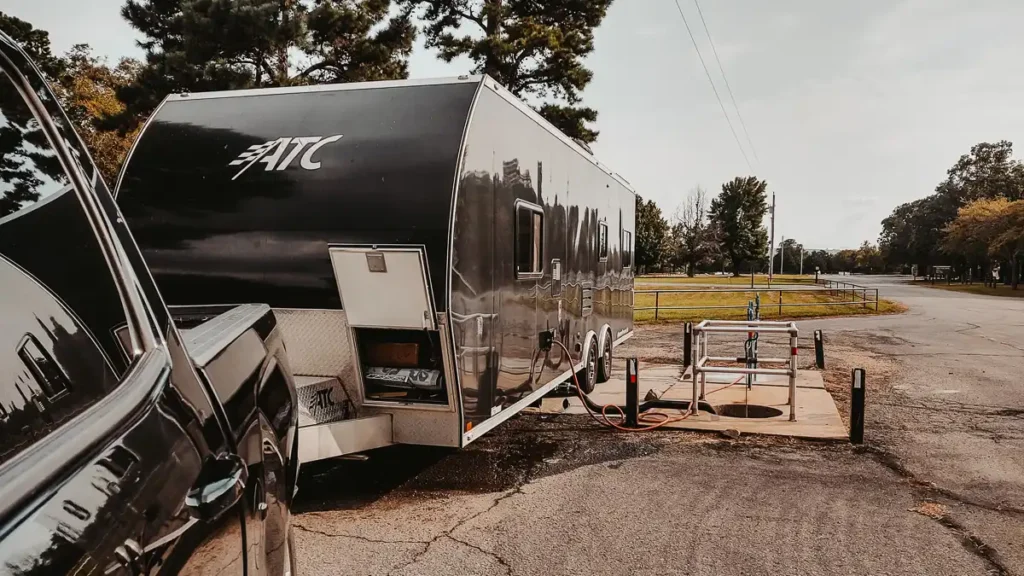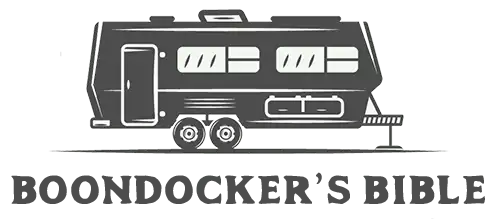How much bleach to sanitize an RV water tank varies from one cup per 40 gallons of water tank capacity to one cup per 60 gallons, depending on who you talk to. We recommend one cup per 50 gallons, just to make the math easier. Otherwise, it doesn’t really hurt your RV to add more bleach if you want to kill everything possible.

How Much Bleach to Sanitize an RV Water Tank?
Most RVers recommend 1 full cup of bleach for every 50 gallons of water tank capacity. Thus, if your water tank can hold 100-gallons of water, use 2 cups of bleach. If your tank holds 25 gallons, use 1/2 cup.
Some RVers recommend going more light at 1 full cup for every 60 gallons of water tank capacity, Others recommend more strong, at 40 gallons of capacity. It just depends on your preference, your peace of mind, and how foul your tank is.
Read our other article, “How to Sanitize an RV Fresh Water Tank“.
Will it Hurt My RV if I Use Too Much Bleach?
Not really. Because you’re only going to leave the bleach solution sit for 8 hours or more, it doesn’t affect the plastic water tank, the Pexate pipes, or the even the water pump itself. You can go with something more strong, maybe 2 cups for every 50 gallons, or 3 cups, and not hurt anything at all.
Keep in mind that bleach itself comes in a plastic jug and it often sits on a shelf for years in some households, and it doesn’t seem to hurt the jug, nor does it seem to hurt a washing machine either.
Am I Using Too Little Bleach?
Interestingly, there’s no such thing as using too little bleach when it comes to sanitizing an RV water tank.
The point is to have “safe” water in your water tank, not 100% disinfected water.
It’s nearly impossible to completely kill every living organism in an RV water tank just by pouring bleach into it. Instead, you just want water that won’t make you sick and water still tolerable to drink. How much bleach that will be is completely up to you.
Some RVers actually add a tablespoon of bleach to their water tank at every refill just for good measure. Bleach at this low level is perfectly safe to drink, and you probably won’t even notice it. In fact, many water districts add a light amount of bleach just to kill off pathogens at a small degree. If you swam in a swimming pool, you’ve already ingested or absorbed bleach.
If you believe your water tank is heavily polluted with bacteria and algae, then certainly use more bleach. It won’t hurt any part of your RV to do so. You should not drink this water considering how much contamination it already has. This is a case where you want to set it for several hours and drain.
Can I Use Any Kind of Bleach?
Yes, common household liquid bleach is what all RVers use. Clorox Beach in a one-gallon jug (see it on Amazon) is perfect. Any brand will do as long as it’s regular household liquid bleach.
- Do not get “Cleaner plus Bleach”.
- Do not get scented bleach.
- Do not get bleach powder.
How Long to Leave Bleach in my RV Water Tank?
Leave bleach in your RV water tank for at least eight (8) hours. You can leave it longer if you want, but least eight hours. It also depends on how much bleach you are using. If you are using the amounts we recommended above, then eight hours is plenty.
What if You Have Too Much Algae in Your Water Tank?
In that case, you may have to remove your water tank and do a more thorough job of cleaning it by hand. It’s possible you may want to take your RV into a shop and have a new water tank put in. It’s not uncommon for full time RVers to get a new tank once every 4-5 years.
How to Test if My RV Water Tank is Clean
The best way, and easiest way, is fill a clear glass with water, hold it up to sunlight, and see what it looks like. If it looks hazy, yellow, or green, then you know its time to sanitize. Otherwise, if the water looks clear and it smells clean, it’s safe for drinking.
If the water looks white, then that just may be aerated water, caused by the water pump or air in the lines. Just let the glass of water sit for a minute to let all the bubbles disappear. Then look at it for color and give it a sniff.


I want to remove bacteria but don’t know how much bleach is enough, I’m afraid I will use too much. Thank you for writing this guide, very helpful for me.
I bought Clorox Beach as your suggestion and used it, very effective as I expected. Fresh scent
Now that I’ve filled up the tank and put bleach in, what’s the best way to empty it? 90 gallon tank. I’m in a park so can’t just dump it.
Shut off your city water, and switch over to water pump, then run all faucets, including shower, and even run the toilet for 30 seconds or more. This will draw all sanitizing water through your lines. Then dump your sewage tanks.
I put bleach in too much 8 cups in 90 gallons. I went to a campground for 8 weeks and only used their water. Now I have a very strong smell of bleach and my wife noticed the color of the water is a light gray when you pour it into a wash ben. I am hoping this coloration is not from any rubber in the system. Any ideas? I am going to dump it today from underneath.
Richie, anytime you put in excessive amounts of bleach to water, it often turns cloudy. This is often what happens with swimming pools when you put in too much chlorine (bleach). The cloudy color is simply an imbalance in water pH. It’s not due to rubber disintegrating.
To effectively sanitize your RV tank requires a bleach solution. You must add ¼ cup of bleach for every 16 gallons of water in your RV’s fresh water tank. This measure is equivalent to one ounce of bleach per eight gallons.
after cleaning my water container with hot, soapy, bleach water & rinsing well with more hot water, how can i know for sure the water is safe to drink or cook with?
For every 40 gallons of water, you would only need one cup of bleach. A 43-ounce bottle of bleach can cost $10 or more depending on the brand, but you can save a lot of money by using it for routine RV water tank cleanup.
Very helpful information my tank needs sanitized now I,know what,to do
Bleach offers a multitude of benefits, catering not only to your RV but also to your personal health and wellness.